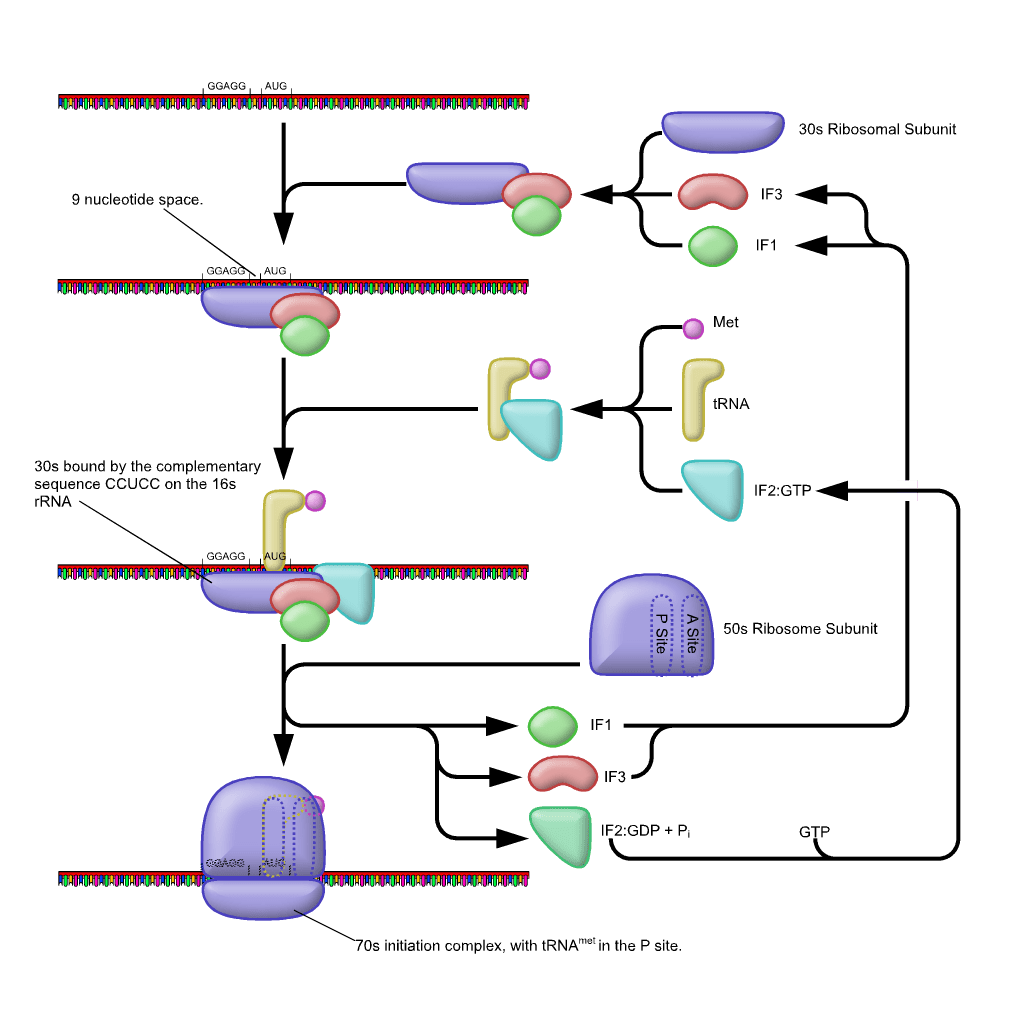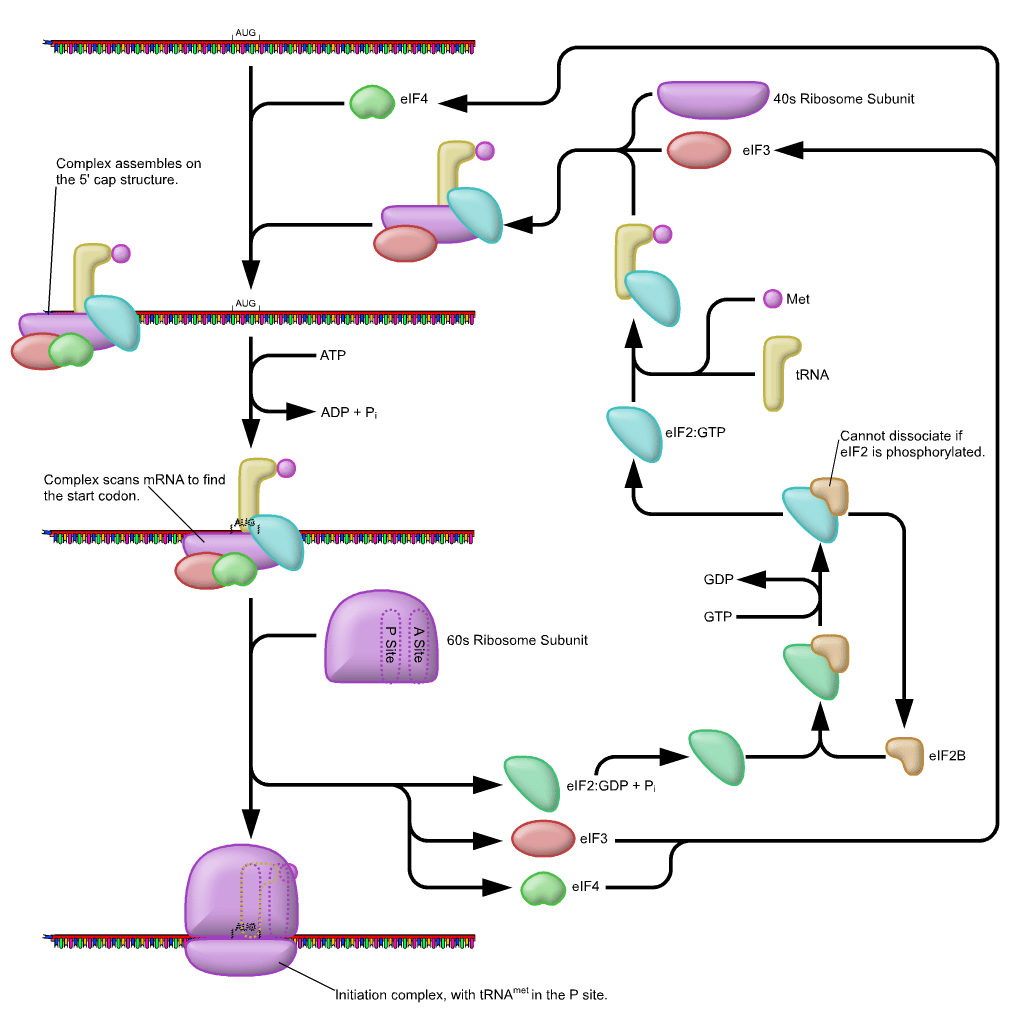What is the Difference Between Prokaryotic and Eukaryotic Translation Initiation
The key difference between prokaryotic and eukaryotic translation initiation is that prokaryotic translation initiation occurs on 70S ribosomes while eukaryotic translation initiation occurs on 80S ribosomes.
Translation or protein synthesis is a biological process that takes place in the cytoplasm. It proceeds via three steps: initiation, elongation and termination. This process involves translating the nucleotide triplets or codons present in the messenger RNA (mRNA) sequence into an amino acid sequence. Translation is carried out by ribosomes and specific enzymes. These catalyze the formation of the polypeptide based on the mRNA template.
CONTENTS
1. Overview and Key Difference
2. What is Prokaryotic Translation Initiation
3. What is Eukaryotic Translation Initiation
4. Similarities – Prokaryotic and Eukaryotic Translation Initiation
5. Prokaryotic vs Eukaryotic Translation Initiation in Tabular Form
6. Summary – Prokaryotic vs Eukaryotic Translation Initiation
What is Prokaryotic Translation Initiation?
Prokaryotic translation initiation is the binding of the 30S ribosomal subunit of the ribosome to the 5’ end of mRNA with the help of prokaryotic initiation factors. The synthesis of proteins begins with the formation of the initiation complex. The initiation complex consists of 30S ribosome, mRNA template, initiation factors like IF-1, IF-2 and IF-3 and special initiator tRNA. In prokaryotes, the Shine Dalgarno sequence takes part in identifying the ribosome to initiate translation. Shine Dalgarno sequence binds with the 30S ribosomal subunit on the mRNA template. In this step, the IF-3 plays an important role. The initiator tRNA then combines with the start codon AUG. This tRNA molecule transports the amino acid methionine.

Figure 01: Prokaryotic Translation
Formylation of methionine is an important process that takes place in prokaryotes. Thus, formylated methionine acts as the first amino acid in prokaryotic translation. The binding of tRNA and methionine (fMet) is mediated by IF-2. The 30S ribosomal subunit together with fMet, IF-1, IF-2 and IF -3 create the initiation complex. The hydrolysis of GTP on IF-2 and release of all initiation factors allow the binding of 30S ribosomal subunit to 50S ribosomal subunit to form a fully functional ribosome, also known as the translation complex. Since the GTP is hydrolysed, the binding of the subunits is irreversibly spontaneous and requires energy to terminate translation.
What is Eukaryotic Translation Initiation?
Eukaryotic translation initiation is the process by which the initiator tRNA, 40S and 60S ribosomal subunits are bound by eukaryotic initiation factors (eIF) into an 80S ribosome at the start codon of mRNA. Eukaryotic translation initiation factors, mRNA transcript, and the ribosome mainly take part in the initiation process. The initiation factors bind to the 40s ribosomal subunit. The initiation factor eIF3 prevents the premature binding of the two subunits, while eIF4 acts as the cap-binding protein. Translation initiation factor eIF2 selects the charged initiator tRNA and binds with methionine to form Met-tRNA. This molecule is not formylated. After this binding process, a ternary complex is formed, which is known as eIF2/GTP/Met-tRNA. This ternary complex binds with other eIFs to the 40S subunit to form a 43S preinitiation complex.

Figure 02: Eukaryotic Translation Initiation
This preinitiation complex with the protein factors moves along the mRNA chain towards the 3’ end to reach the start codon. This process is known as the scanning of mRNA. GTP hydrolysis takes place at eIF2 that activates the dissociation of translation initiation factors from the 40s subunit leading to the formation of the full ribosome complex. This marks the end of eukaryotic translation initiation and proceeds to the elongation phase.
Similarities Between Prokaryotic and Eukaryotic Translation Initiation
- Both processes use an mRNA template.
- tRNA brings up the correct amino acid in both processes.
- Both ribosomal subunits take part in translation initiation.
- GTP hydrolysis takes place in both processes to activate translation initiation.
- AUG acts as the start codon for both processes.
Difference Between Prokaryotic and Eukaryotic Translation Initiation
Prokaryotic translation initiation takes place on 70s ribosomes, while eukaryotic translation initiation takes place on 80s ribosomes. So, this is the key difference between prokaryotic and eukaryotic translation initiation. Moreover, prokaryotic translation initiation is a cap-independent process, while eukaryotic translation initiation is cap-dependent and cap-independent. Thus, this is another significant difference between prokaryotic and eukaryotic translation initiation. Besides, the chain initiating amino acids of prokaryotic translation initiation and eukaryotic translation initiation are N-formyl methionine and methionine, respectively.
The following infographic compiles the differences between prokaryotic and eukaryotic translation initiation in tabular form for side by side comparison.
Summary – Prokaryotic vs Eukaryotic Translation Initiation
Translation is a biological process that takes place in the cytoplasm. Initiation is the first step of translation. An mRNA transcript acts as the template for both prokaryotic and eukaryotic translation initiation. Prokaryotic translation initiation is the binding of the 30S ribosomal subunit of the ribosome to the 5’ end of mRNA with the help of prokaryotic initiation factors. The initiation factors include IF-1, IF-2 and IF-3, while 70s ribosomes act as the main translation machinery involved in the initiation process. Eukaryotic translation initiation is the process by which the initiator tRNA, 40S and 60S ribosomal subunits are bound by eukaryotic initiation factors (eIF) into an 80S ribosome at the start codon of mRNA. The initiation factors include eIF-1, eIF2, eIF-3, eIF4, eIF5 and eIF6 while 80s ribosomes act as the machinery for the initiation of translation in eukaryotes. Thus, this is the summary of the difference between prokaryotic and eukaryotic translation initiation.
Reference:
1. “Prokaryotic Translation.” Lumen Learning.
2. Pestova, T., Kolupaeva, V., Lomakin, I., Pilipenko, E., Shatsky, I., Agol, V., & Hellen, C. “Molecular mechanisms of translation initiation in eukaryotes.” PNAS.
Image Courtesy:
1. “Prokaryotic Translation Initiation” (CC BY-SA 3.0) via Commons Wikimedia
2. “Eukaryotic Translation Initiation” By – Zephyris assumed – No machine-readable source provided. Own work assumed (based on copyright claims) (CC BY-SA 3.0) via Commons Wikimedia
ncG1vNJzZmivp6x7pbXFn5yrnZ6YsqOx07CcnqZemLyue9ahmK1lmah6tbTEZpuinpaav6a6wp5km52krLKmuoypqaijkafGsMDInGSappRisra3wKuwqKyZmHq1vsCnqqWZpJ68r3nIp6CtoZGptrC6jg%3D%3D